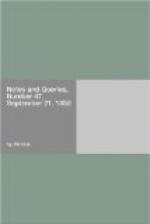St. Thomas of Lancaster (Vol. i., p. 181.).—MR. R.M. MILNES desires information relative to “St. Thomas of Lancaster.” This personage was Earl of Leicester as well as Earl of Lancaster; and I find in the archives of this borough numerous entries relative to him,—of payments made to him by the burgesses. Of these mention is made in a History of Leicester recently published. The most curious fact I know of is, that on the dissolution of the monasteries here, several relics of St. Thomas, among others, his felt hat, was exhibited. The hat was considered a great remedy for the headache!
JAYTEE.
Smoke Money (Vol. ii., p. 120.).—“Anciently, even in England, were Whitsun farthings, or smoke farthings, which were a composition for offerings made in Whitsun week, by every man who occupied a house with a chimney, to the cathedral of the diocese in which he lived.”—Audley’s Companion to the Almanac, p. 76.
Pentecostals, or Whitsun Farthings, are mentioned by Pegge as being paid in 1788 by the parishioners of the diocese of Lichfield, in aid of the repairs of the cathedral, to the dean and chapter; but he makes no allusion to the word smoke, adding only that in this case the payment went by the name of Chad-pennies, or Chad-farthings, the cathedral there being dedicated to St. Chad.
C.I.R.
Robert Herrick (Vol. i., p. 291.).—MR. MILNER BARRY states that he found an entry of the burial of the poet Herrick in the parish books of Dean Prior. As MR. BARRY seems interested in the poet, I would inform him that a voluminous collection of family letters of early date is now in the possession of William Herrick, Esq., of Beaumanor Park, the present representative of that ancient and honourable house.
JAYTEE.
Guildhalls.—The question in Vol. i., p. 320., relative to guildhalls, provokes an inquiry into {270} guilds. In the erudite and instructive work of Wilda on the Guild System of the Middle Ages (Gildenwesen im Mittelaelter) will be found to be stated that guilds were associations of various kinds,—convivial, religions, and mercantile, and so on; and that places of assembly were adopted by them. A guild-house where eating and drinking took place, was to be met with in most villages in early times: and these, I fancy, were the guild-halls. On this head consult Hone’s Every-day Book, vol. ii. p. 670., and elsewhere, in connexion with Whitsuntide holidays.
JAYTEE.
Abbe Strickland (Vol. ii., pp. 198. 237.).—The fullest account of the Abbe Strickland, Bishop of Namur, is to be found in Lord Hervey’s Memoirs (Vol. i., p. 391.), and a most curious account it is of that profligate intriguer.




